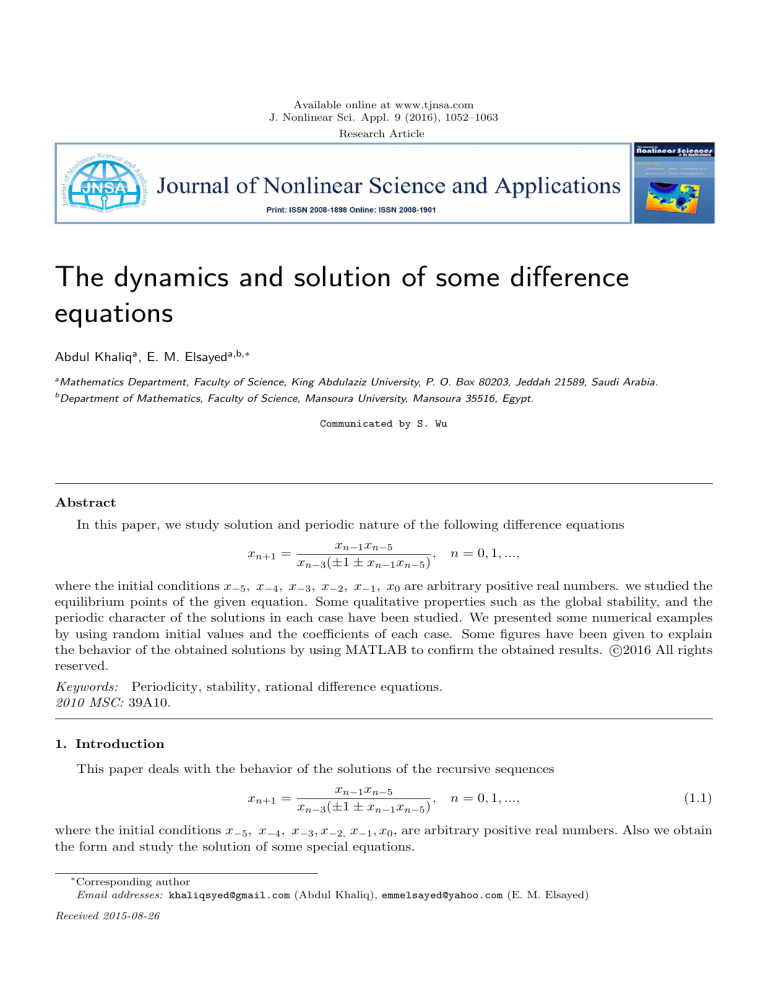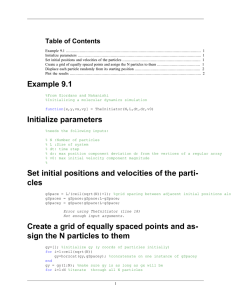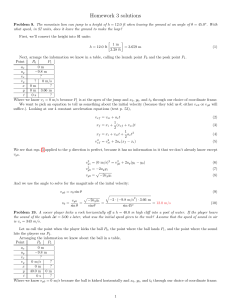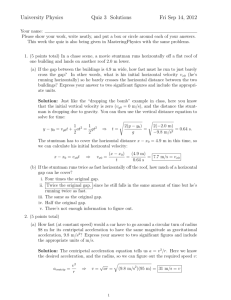
Available online at www.tjnsa.com
J. Nonlinear Sci. Appl. 9 (2016), 1052–1063
Research Article
The dynamics and solution of some difference
equations
Abdul Khaliqa , E. M. Elsayeda,b,∗
a
Mathematics Department, Faculty of Science, King Abdulaziz University, P. O. Box 80203, Jeddah 21589, Saudi Arabia.
b
Department of Mathematics, Faculty of Science, Mansoura University, Mansoura 35516, Egypt.
Communicated by S. Wu
Abstract
In this paper, we study solution and periodic nature of the following difference equations
xn+1 =
xn−1 xn−5
,
xn−3 (±1 ± xn−1 xn−5 )
n = 0, 1, ...,
where the initial conditions x−5 , x−4 , x−3 , x−2 , x−1 , x0 are arbitrary positive real numbers. we studied the
equilibrium points of the given equation. Some qualitative properties such as the global stability, and the
periodic character of the solutions in each case have been studied. We presented some numerical examples
by using random initial values and the coefficients of each case. Some figures have been given to explain
the behavior of the obtained solutions by using MATLAB to confirm the obtained results. c 2016 All rights
reserved.
Keywords: Periodicity, stability, rational difference equations.
2010 MSC: 39A10.
1. Introduction
This paper deals with the behavior of the solutions of the recursive sequences
xn+1 =
xn−1 xn−5
,
xn−3 (±1 ± xn−1 xn−5 )
n = 0, 1, ...,
(1.1)
where the initial conditions x−5 , x−4 , x−3 , x−2, x−1 , x0 , are arbitrary positive real numbers. Also we obtain
the form and study the solution of some special equations.
∗
Corresponding author
Email addresses: khaliqsyed@gmail.com (Abdul Khaliq), emmelsayed@yahoo.com (E. M. Elsayed)
Received 2015-08-26
A. Khaliq, E. M. Elsayed, J. Nonlinear Sci. Appl. 9 (2016), 1052–1063
1053
The study and solution of nonlinear rational recursive sequence of high order is quite challenging and
rewarding. Recently, there has been a lot of interest in studying the qualitative properties of rational recursive
sequences, Furthermore diverse nonlinear trend occurring in science and engineering can be modeled by such
equations and the solution about such equations offer prototypes towards the development of the theory.
However, there have not been any suitable general method to deal with the global behavior of rational
difference equations of high order so far. Therefore, the study of rational difference equations of order
greater than one is worth further consideration.
Aloqeili [2] has obtained the solutions of the difference equation
xn+1 =
xn−1
.
a − xn xn−1
Cinar [4] investigated the solutions of the following difference equation
xn+1 =
xn−1
.
1 + axn xn−1
Ibrahim [16] studied the solutions of the rational recursive sequence
xn+1 =
xn xn−2
.
xn−1 (a + bxn xn−2)
Karatas et al [17] gave the solution of the following difference equation
xn+1 =
xn−5
.
1 + xn−2 xn−5
Simsek et al. [26] investigated the global stability, periodicity character and gave the solution of some special
cases of the difference equation
xn−3
xn+1 =
.
1 + xn−1
Yalçınkaya [31] has studied the boundedness, global stability, periodicity character and gave the solution of
some special cases of the difference equation
xn+1 =
a.xn−k
.
b + cxpn
Yalçınkaya [30] has studied the following difference equation
xn+1 = α +
xn−m
.
xkn
See also [1]-[19]. Other related work on rational difference equations see in Refs. [20]-[34].
Here, we recall some basic definitions and some theorems that we need in the sequel.
Let I be some interval of real numbers and let
F : I k+1 → I
(1.2)
be a continuously differentiable function. Then for every set of initial conditions x−k , x−k+1 , ...,x0 ∈ I, the
difference equation
xn+1 = F (xn , xn−1 , ..., xn−k ), n = 0, 1, ...
(1.3)
has a unique solution {xn }∞
n=−k .
Definition 1.1 (Equilibrium Point). A point x ∈ I is called an equilibrium point of (1.3) if
x = F (x, x, ..., x).
That is, xn = x for n ≥ 0, is a solution of (1.3), or equivalently, x is a fixed point of f .
A. Khaliq, E. M. Elsayed, J. Nonlinear Sci. Appl. 9 (2016), 1052–1063
1054
Definition 1.2 (Periodicity). A Sequence {xn }∞
n=−k is said to be periodic with period p if xn+p = xn for
all n ≥ −k.
Definition 1.3 (Stability).
(i) The equilibrium point x of (1.3) is locally stable if for every > 0, there exists δ > 0 such that for
all x−k , x−k+1 , ..., x−1 , x0 ∈ I with
|x−k − x| + |x−k+1 − x| + ... + |x0 − x| < δ,
we have
|xn − x| < for all n ≥ −k.
(ii) The equilibrium point x of (1.3) is locally asymptotically stable if x is locally stable solution of (1.3)
and there exists γ > 0, such that for all x−k , x−k+1 , ..., x−1 , x0 ∈ I with
|x−k − x| + |x−k+1 − x| + ... + |x0 − x| < γ,
we have
lim xn = x.
n→∞
(iii) The equilibrium point x of (1.3) is global attractor if for all x−k , x−k+1 , ..., x−1 , x0 ∈ I, we have
lim xn = x.
n→∞
(iv) The equilibrium point x of (1.3) is globally asymptotically stable if x is locally stable, and x is also a
global attractor of (1.3).
(v) The equilibrium point x of (1.3) is unstable if x is not locally stable.
(vi) The linearized equation of (1.3) about the equilibrium x is the linear difference equation.
yn+1 =
k
P
i=0
∂F (x,x,...,x)
yn−i .
∂xn−i
Theorem A ([18]). Assume that p, q ∈ R and k ∈ {0, 1, 2, ...}. Then
|p| + |q| < 1,
is a sufficient condition for the asymptotic stability of the difference equation
xn+1 + pxn + qxn−k = 0,
n = 0, 1, ... .
Remark 1.4. Theorem A can be easily extended to a general linear equations of the form
xn−k + p1 xn+k−1 + · · · + pk xn = 0, n = 0, 1, 2, · · · ,
where p1 , p2 , ..., pk ∈ R and k ∈ {1, 2, · · · }. Then Eq. (1.4) is asymptotically stable provided that
k
X
| pi | < 1.
i=1
2. On the Equation xn+1 = xn−1 xn−5 /(xn−3 (1 + xn−1 xn−5 ))
In this section, we give a specific form of the solution of the first equation in the form
(1.4)
A. Khaliq, E. M. Elsayed, J. Nonlinear Sci. Appl. 9 (2016), 1052–1063
xn−1 xn−5
,
xn−3 (1 + xn−1 xn−5 )
xn+1 =
1055
n = 0, 1, ...,
(2.1)
where the initial values are arbitrary non-zero real numbers.
Theorem 2.1. Let {xn }∞
n=−5 be a solution of Eq. (2.1). Then for n = 0, 1, ...,
x8n−5 = f
x8n−3 = d
x8n−1
x8n+1
n−1
Y
i=1
n−1
Y
i=1
n−1
Y
1 + 4ibf
1 + (4i + 2)bf
1 + (4i + 1)bf
1 + (4i + 3)bf
n−1
Y
,
,
1 + (4i + 2)bf
,
= b
1 + (4i + 4)bf
i=1
n−1
Y 1 + (4i + 3)bf bf
=
,
d(1 + bf )
1 + (4i + 5)bf
i=1
where
1 + 4iae
x8n−4 = e
,
1 + (4i + 2)ae
i=1
n−1
Y 1 + (4i + 1)ae x8n−2 = c
,
1 + (4i + 3)ae
i=1
n−1
Y 1 + (4i + 2)ae x8n = a
,
1 + (4i + 4)ae
i=1
n−1
Y 1 + (4i + 3)ae ae
x8n+2 =
,
c(1 + ae)
1 + (4i + 5)ae
i=1
x−5 = f, x−4 = e, x−3 = d, x−2 = c, x−1 = b, x0 = a.
Proof. For n = 0, the result holds. Now, suppose that n > 0 and that our assumption holds for n − 1. That
is,
n−2
n−2
Y 1 + 4iae Y 1 + 4ibf ,
x8n−12 = e
,
x8n−13 = f
1 + (4i + 1)bf
1 + (4i + 2)ae
i=1
i=1
n−2
n−2
Y 1 + (4i + 1)ae Y 1 + (4i + 1)bf ,
x8n−10 = c
,
x8n−11 = d
1 + (4i + 3)bf
1 + (4i + 3)ae
i=1
i=1
n−2
n−2
Y 1 + (4i + 2)bf Y 1 + (4i + 2)ae x8n−9 = b
,
x8n−8 = a
,
1 + (4i + 4)bf
1 + (4i + 4)ae
i=1
i=1
n−2
n−2
Y 1 + (4i + 3)bf Y 1 + (4i + 3)ae bf
ae
x8n−7 =
,
x8n−6 =
.
d(1 + bf )
1 + (4i + 5)bf
c(1 + ae)
1 + (4i + 5)ae
i=1
i=1
Now, it follows from (2.1) that,
x8n−7 x8n−11
x8n−5 =
x8n−9 (1 + x8n−7 x8n−11 )
n−2
Y 1 + (4i + 1)bf 1 + (4i + 3)bf
d
1 + (4i + 5)bf
1 + (4i + 3)bf
i=1
i=1
!
n−2
n−2
Y 1 + (4i + 1)bf Y 1 + (4i + 2)bf Y 1 + (4i + 3)bf n−2
bf
b
1+
d
1 + (4i + 4)bf
d(1 + bf )
1 + (4i + 5)bf
1 + (4i + 3)bf
i=1
i=1
i=1
n−2
Y 1 + (4i + 1)bf
bf
d(1+bf )
1 + (4i + 5)bf
i=1
!
n−2
n−2
Y 1 + (4i + 2)bf Y 1 + (4i + 1)bf bf
1+
b
1 + (4i + 4)bf
d(1 + bf )
1 + (4i + 5)bf
i=1
i=1
bf
d(1+bf )
=
=
n−2
Y
bf
1+(4n+1)bf
=
b
n−2
Y
i=1
1 + (4i + 2)bf
1 + (4i + 4)bf
1+
bf
1 + (4n + 1)bf
A. Khaliq, E. M. Elsayed, J. Nonlinear Sci. Appl. 9 (2016), 1052–1063
1056
f
1 + (4i + 2)bf
(1 + (4n + 1)bf + bf )
1 + (4i + 4)bf
i=1
n−2
Y 1 + (4i + 4)bf 1
= f
.
1 + (4i + 2)bf (1 + (4n + 2)bf )
=
n−2
Y
i=1
Hence we have
x8n−5 = f
n−1
Y
i=1
1 + 4ibf
1 + (4i + 2)bf
.
Similarly we see that,
x8n+1 =
=
=
x8n−1 x8n−5
x8n−3 (1 + x8n−17 x8n−5 )
n−2
Y 1 + 4ibf Y 1 + (4i + 2)bf n−2
f
b
1 + (4i + 4)bf
1 + (4i + 2)bf
i=1
i=1
!
n−2
n−2
Y 1 + (4i + 1)bf
Y 1 + (4i + 2)bf n−2
Y 1 + 4ibf d
1+b
f
1 + (4i + 3)bf
1 + (4i + 4)bf
1 + (4i + 2)bf
i=1
i=1
i=1
n−2
Y 1 + (4i)bf bf
1 + (4i + 4)bf
i=1
!
n−2
n−2
Y 1 + (4i + 1)bf
Y 1 + (4i)bf d
1 + bf
1 + (4i + 3)bf
1 + (4i + 4)bf
i=1
i=1
bf
1+4nbf
=
d
n−2
Y
i=1
=
1 + (4i + 1)bf
1 + (4i + 3)bf
1+
bf
1 + 4nbf
bf
n−2
Y
1 + (4i + 1)bf
d
(1 + 4nbf + bf )
1 + (4i + 3)bf
i=1
n−2
Y 1 + (4i + 3)bf bf
=
.
1 + (4i + 1)bf d (1 + (4n + 1)bf )
i=1
Hence we have,
x8n+1
n−1
Y 1 + (4i + 3)bf bf
=
.
d (1 + bf )
1 + (4i + 5)bf
i=1
Similarly, one can easily obtain the other relations. Thus, the proof is completed.
Theorem 2.2. Eq. (2.1) has a unique equilibrium point which is x = 0, and is not locally asymptotically
stable.
Proof. From Eq. (2.1), we see that
x=
x2
,
x(1 + x2 )
or
x2 (1 + x2 − 1) = 0,
x4 = 0.
A. Khaliq, E. M. Elsayed, J. Nonlinear Sci. Appl. 9 (2016), 1052–1063
1057
Thus the equilibrium point of Eq. (2.1) is x = 0.
Let f : (0, ∞)3 −→ (0, ∞) be a continuously differentiable function defined by
uw
.
v(1 + uw)
f (u, v, w) =
Therefore at x = 0, we get
∂f
∂u
= 1,
x
∂f
∂v
= 1,
x
∂f
∂w
= 1.
x
The proof follows by using Theorem A.
Now, we consider some numerical examples which represent different types of solutions to Eq. (2.1).
Example 2.3. We assume x−5 = 13, x−4 = 7, x−3 = 19, x−2 = 10, x−1 = 15, x0 = 10. (See Figure 1).
plot of xn+1= xn−1.xn−5/( xn−3.(1+ xn−1. xn−5))
20
18
16
14
x(n)
12
10
8
6
4
2
0
0
10
20
30
40
50
60
70
80
90
n
Figure 1
Example 2.4. See Figure 2, where we put x−5 = 4, x−4 = 7, x−3 = 2, x−2 = 6, x−1 = 9, x0 = 1.
plot of xn+1= xn−1.xn−5/( xn−3.(1+ xn−1. xn−5))
9
8
7
x(n)
6
5
4
3
2
1
0
0
10
20
30
40
50
n
Figure 2
60
70
80
90
A. Khaliq, E. M. Elsayed, J. Nonlinear Sci. Appl. 9 (2016), 1052–1063
1058
3. On the Equation xn+1 = xn−1 xn−5 /(xn−3 (−1 + xn−1 xn−5 ))
In this section, we give a specific form of the solution of the second equation in the form
xn+1 =
xn−1 xn−5
,
xn−3 (−1 + xn−1 xn−5 )
n = 0, 1, ...,
(3.1)
where the initial values are arbitrary non zero real numbers with x−1 x−5 , x0 x−4 6= 1.
Theorem 3.1. Let {xn }∞
n=−5 be a solution of Eq. (3.1) Then every solution of Eq. (3.1) is periodic with
period 8. Moreover, {xn }∞
n=−5 takes the form
bf
ae
f, e, d, c, b, a,
,
, f, e, d, c, b, a, ... ,
d(−1 + bf ) c(−1 + ae)
or,
x8n−5 = f,
x8n−1 = b,
x8n−4 = e,
x8n−3 = d,
x8n = a,
x8n+1
x8n−2 = c,
bf
=
,
d(−1 + bf )
x8n+2 =
ae
.
c(−1 + ae)
Proof. As proof of Theorem 2.1 so will be omitted.
√
Theorem 3.2. Eq. (3.1) has two equilibrium points which are 0, ± 2 and these equilibrium points are not
locally asymptotically stable.
Proof. For the equilibrium points of Eq. (3.1), we can write
x=
x2
,
x(−1 + x2 )
or
x2 (x2 − 2) = 0.
√
Thus, the equilibrium points of Eq. (3.1) are 0 and ± 2.
Let f : (0, ∞)3 −→ (0, ∞) be a continuously differentiable function defined by
f (u, v, w) =
Therefore at x = 0
∂f
∂u
= −1,
x
∂f
∂v
uw
.
v(1 + uw)
= ±1,
x
∂f
∂w
= −1.
x
The proof follows by using Theorem A.
Example 3.3. We assume x−5 = 3, x−4 = 7, x−3 = 9, x−2 = 10, x−1 = 7, x0 = 4/9. ( See Figure 3).
Example 3.4. See Figure 4 when we take x−5 = 4, x−4 = 7, x−3 = 2, x−2 = 6, x−1 = 9, x0 = 1.
A. Khaliq, E. M. Elsayed, J. Nonlinear Sci. Appl. 9 (2016), 1052–1063
1059
plot of xn+1= xn−1.xn−5/( xn−3.(−1+ xn−1. xn−5))
10
9
8
7
x(n)
6
5
4
3
2
1
0
0
10
20
30
40
50
60
70
80
90
n
Figure 3
plot of xn+1= xn−1.xn−5/( xn−3.(−1+ xn−1. xn−5))
9
8
7
x(n)
6
5
4
3
2
1
0
0
10
20
30
40
50
60
70
80
90
n
Figure 4
The following cases can be proved similarly.
4. On the Equation xn+1 = xn−1 xn−5 /(xn−3 (1 − xn−1 xn−5 ))
In this section, we obtain the form of the solution of the third equation in the form
xn+1 =
xn−1 xn−5
,
xn−3 (1 − xn−1 xn−5 )
n = 0, 1, ...,
where the initial values are arbitrary non zero real numbers.
Theorem 4.1. Let {xn }∞
n=−5 be a solution of Eq. (4.1). Then for n = 0, 1, ..., we see that
x8n−5 = f
x8n−3 = d
n−1
Y
i=1
n−1
Y
i=1
1 − 4ibf
1 − (4i + 2)bf
1 − (4i + 1)bf
1 − (4i + 3)bf
,
,
n−1
Y
1 − 4iae
x8n−4 = e
,
1 − (4i + 2)ae
i=1
n−1
Y 1 − (4i + 1)ae x8n−2 = c
,
1 − (4i + 3)ae
i=1
(4.1)
A. Khaliq, E. M. Elsayed, J. Nonlinear Sci. Appl. 9 (2016), 1052–1063
x8n−1
x8n+1
n−1
Y
1060
n−1
Y
1 − (4i + 2)bf
= b
,
1 − (4i + 4)bf
i=1
n−1
Y 1 − (4i + 3)bf bf
,
=
d(1 − bf )
1 − (4i + 5)bf
1 − (4i + 2)ae
x8n = a
,
1 − (4i + 4)ae
i=1
n−1
Y 1 − (4i + 3)ae ae
x8n+2 =
.
c(1 − ae)
1 − (4i + 5)ae
i=1
i=1
Theorem 4.2. Eq. (4.1) has a unique equilibrium point which is x = 0, and is not locally asymptotically
stable.
Example 4.3. We put the initial conditions as follows x−5 = 2, x−4 = 5, x−3 = 9, x−2 = 5, x−1 = 1, x0 =
3. (See Figure 5).
Example 4.4. See Figure 6, since x−5 = 3, x−4 = 7, x−3 = 2, x−2 = 6, x−1 = 8, x0 = 2/5.
plot of xn+1= xn−1.xn−5/( xn−3.(1− xn−1. xn−5))
10
8
x(n)
6
4
2
0
−2
0
10
20
30
40
50
60
70
80
90
80
90
n
Figure 5
plot of xn+1= xn−1.xn−5/( xn−3.(1− xn−1. xn−5))
8
7
6
5
x(n)
4
3
2
1
0
−1
−2
0
10
20
30
40
50
60
70
n
Figure 6
5. On the Equation xn+1 = xn−1 xn−5 /(xn−3 (−1 − xn−1 xn−5 ))
In this section, we get the solutions form of the fourth difference equation as follows
xn+1 =
xn−1 xn−5
,
xn−3 (−1 − xn−1 xn−5 )
n = 0, 1, ...,
where the initial values are arbitrary non zero real numbers with x−1 x−5 , x0 x−4 6= −1.
(5.1)
A. Khaliq, E. M. Elsayed, J. Nonlinear Sci. Appl. 9 (2016), 1052–1063
1061
Theorem 5.1. Let {xn }∞
n=−5 be a solution of Eq. (5.1) Then every solution of it is periodic with period 8.
∞
Moreover, {xn }n=−5 takes the form
bf
ae
f, e, d, c, b, a,
,
, f, e, d, c, b, a, ... ,
d(−1 − bf ) c(−1 − ae)
or,
x8n−5 = f,
x8n−1 = b,
x8n−4 = e,
x8n−3 = d,
x8n = a,
x8n+1
x8n−2 = c,
bf
=
,
d(−1 − bf )
x8n+2 =
ae
.
c(−1 − ae)
Example 5.2. We suppose that x−5 = 9, x−4 = 7, x−3 = 12, x−2 = 3, x−1 = 2, x0 = 5. ( See Figure 7).
Example 5.3. Figure 8, shows the periodicity of the solution when x−5 = −7, x−4 = 5, x−3 = 8, x−2 = 6,
x−1 = 9, x0 = 5/9.
plot of xn+1= xn−1.xn−5/( xn−3.(−1− xn−1. xn−5))
12
10
8
x(n)
6
4
2
0
−2
0
5
10
15
20
n
25
30
35
40
35
40
Figure 7
plot of xn+1= xn−1.xn−5/( xn−3.(−1− xn−1. xn−5))
10
x(n)
5
0
−5
−10
0
5
10
15
20
n
25
30
Figure 8
Acknowledgements
This article was funded by the Deanship of Scientific Research (DSR), King Abdulaziz University, Jeddah.
The authors, therefore, acknowledge with thanks DSR technical and financial support.
A. Khaliq, E. M. Elsayed, J. Nonlinear Sci. Appl. 9 (2016), 1052–1063
1062
References
[1] R. Agarwal, Difference Equations and Inequalities: Theory, Methods and Applications, Marcel Dekker Inc., New
York, (1992). 1
[2] M. Aloqeili, Dynamics of a rational difference equation, Appl. Math. Comput., 176 (2006), 768–774. 1
[3] M. B. Bekker, M. J. Bohner, H. D. Voulov, Asymptotic behavior of solutions of a rational system of difference
equations, J. Nonlinear Sci. Appl., 7 (2014), 379–382.
ax
[4] C. Cinar, On the positive solutions of the difference equation xn+1 = 1+bxnn−1
, Appl. Math. Comp., 156 (2004),
xn−1
587–590. 1
xn + αxn−1
, Appl. Math. Comput., 181
[5] H. Chen, H. Wang, Global attractivity of the difference equation xn+1 =
β + xn
(2006), 1431–1438.
[6] Q. Din, E. M. Elsayed, Stability analysis of a discrete ecological model, Comput. Ecol. Softw., 4 (2014), 89–103.
αxn−k
[7] E. M. Elabbasy, H. El-Metwally, E. M. Elsayed, On the difference equations xn+1 =
, J. Concr.
Q
β + γ ki=0 xn−i
Appl. Math., 5 (2007), 101–113.
[8] E. M. Elabbasy, H. El-Metwally, E. M. Elsayed, Qualitative behavior of higher order difference equation, Soochow
J. Math., 33 (2007), 861–873.
[9] E. M. Elsayed, Qualitative behaviour of difference equation of order two, Math. Comput. Modelling, 50 (2009),
1130–1141.
[10] E. M. Elsayed, Solution and attractivity for a rational recursive sequence, Discrete Dyn. Nat. Soc., 2011 (2011),
17 pages.
[11] E. M. Elsayed, Behavior and expression of the solutions of some rational difference equations, J. Comput. Anal.
Appl., 15 (2013), 73–81.
[12] E. M. Elsayed, Solution for systems of difference equations of rational form of order two, Comput. Appl. Math,
33 (2014), 751–765.
[13] E. M. Elsayed, On the solutions and periodic nature of some systems of difference equations, Int. J. Biomath, 7
(2014), 26 pages.
[14] E. M. Elsayed, New method to obtain periodic solutions of period two and three of a rational difference equation,
Nonlinear Dynam., 79 (2015), 241–250.
[15] E. M. Elsayed, M. M. El-Dessoky, Dynamics and global behavior for a fourth-order rational difference equation,
Hacet. J. Math. Stat., 42 (2013), 479–494.
xn xn−2
[16] T. F. Ibrahim, On the third order rational difference equation xn+1 =
, Int. J. Contemp.
xn−1 (a + bxn xn−2 )
Math. Sci., 4 (2009), 1321–1334. 1
xn−5
[17] R. Karatas, C. Cinar, D. Simsek, On positive solutions of the difference equation xn+1 = 1+xn−2
, Int. J.
xn−5
Contemp. Math. Sci., 1 (2006), 495–500. 1
[18] V. L. Kocic, G. Ladas, Global Behavior of Nonlinear Difference Equations of Higher Order with Applications,
Kluwer Academic Publishers, Dordrecht, (1993). 1
[19] M. R. S. Kulenovic, G. Ladas, Dynamics of Second Order Rational Difference Equations with Open Problems and
Conjectures, Chapman & Hall, CRC Press, London, (2001). 1
[20] A. S. Kurbanli, On the behavior of solutions of the system of rational difference equations, World Appl. Sci. J.,
10 (2010), 1344–1350. 1
[21] H. Ma, H. Feng, J. Wang, W. Ding, Boundedness and asymptotic behavior of positive solutions for difference
equations of exponential form, J. Nonlinear Sci. Appl., 8 (2015), 893–899.
[22] R. Memarbashi, Sufficient conditions for the exponential stability of nonautonomous difference equations, Appl.
Math. Lett., 21 (2008), 232–235.
[23] A. Neyrameh, H. Neyrameh, M. Ebrahimi, A. Roozi, Analytic solution diffusivity equation in rational form,
World Appl. Sci. J., 10 (2010), 764–768.
yn
[24] M. Saleh, M. Aloqeili, On the difference equation yn+1 = A +
with A < 0, Appl. Math. Comp., 176 (2006),
yn−k
359–363.
yn
, Appl. Math. Comp., 171 (2005), 862–869.
[25] M. Saleh, M. Aloqeili, On the difference equation yn+1 = A +
yn−k
xn−3
[26] D. Simsek, C. Cinar, I. Yalcinkaya, On the recursive sequence xn+1 = 1+x
, Int. J. Contemp. Math. Sci., 1
n−1
(2006), 475–480. 1
xn−5
, Int. J. Pure Appl.
[27] D. Simsek, C. Cınar, R. Karatas, I. Yalcinkaya, On the recursive sequence xn+1 = 1+xn−1
xn−3
Math., 28 (2006), 117–124.
xn−1
[28] T. Sun, H. Xi, On convergence of the solutions of the difference equation xn+1 = 1 +
, J. Math. Anal. Appl.,
xn
325 (2007) 1491–1494.
[29] W. Wang, J. Tian, Difference equations involving causal operators with nonlinear boundary conditions, J. Nonlinear Sci. Appl., 8 (2015), 267–274.
x
[30] I. Yalçınkaya, On the difference equation xn+1 = α + n−m
, Discrete Dyn. Nat. Soc., 2008 (2008), 8 pages. 1
xk
n
A. Khaliq, E. M. Elsayed, J. Nonlinear Sci. Appl. 9 (2016), 1052–1063
[31] I. Yalcinkaya, C. Cinar, On the dynamics of difference equation
1063
a.xn−k
, Fasciculi Mathematici, 42 (2009),
b + cxpn
141–148. 1
α+βx +γx
, Comm. Appl.
[32] E. M. E. Zayed, M. A. El-Moneam, On the rational recursive sequence xn+1 = A+Bxnn +Cxn−1
n−1
Nonlinear Anal., 12 (2005), 15–28.
αx +βxn−1 +γxn−2 +δxn−3
[33] E. M. E. Zayed, M. A. El-Moneam, On the rational recursive sequence xn+1 = Axnn+Bxn−1
, Comm.
+Cxn−2 +Dxn−3
Appl. Nonlinear Anal., 12 (2005), 15–28.
[34] B. G. Zhang, C. J. Tian, P. J. Wong, Global attractivity of difference equations with variable delay, Dynam.
Contin. Discrete Impuls. Systems, 6 (1999), 307–317. 1








